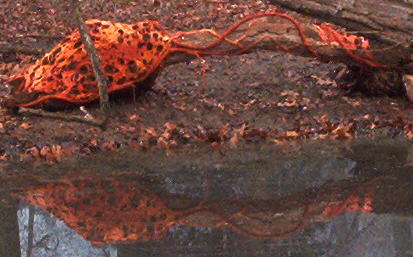

Although not set in Turn of the Century England as author H.G. Wells did in his 1898 novel, War of the Worlds, the 2005 film adaptation by Steven Spielberg appears to remain loyal to many of the original symbols Wells used. While Spielberg is filming in locations from Bayonne, Newark, Staten Island and the swamps of central New Jersey to Athens, New York and places in Virginia, he appears to be holding true to the multi-dimensional aspects of Wells' novel. This includes the environmental theme Wells emphasized.
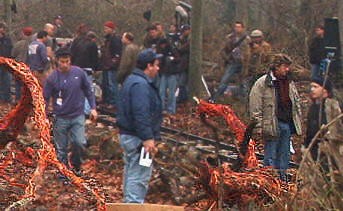
Wells was writing in at a time when Industrialization had taken on new vigor and world travel made it possible to reach nearly every corner of the globe. Most of his novels - despite being shaped as science fiction - tended to be forecasters of future impacts of then contemporary trends. In The Time Machine, for instance, he forecasted the diabolical potential of the emerging middle class, shaping a future society in which the privileged upperly mobile would become victims to a working and fully functional working class, predicting the modern day wealthy class dependence upon people who actually know how to deliver services.
While War of the Worlds have numerous themes, among the most central is that of the environmental impact of an invasion from space. On the Staten Island shoot, film crews were seen spreading a vine-like sea-weed like substance. This was most evident on the huge highway sign depicting an approach to Boston (part of the film-making magic film a scene on Staten Island but make the viewer believe he or she is approaching Boston 500 miles away.)
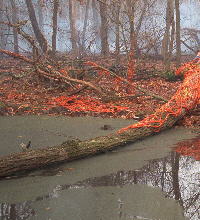
These vines had initially suggested to me the passing of time but a reader and later a check with the original work showed that this was not the case, but gave additional clues to the mindset of the filmmaker who appears dedicated to using as much of the original novel as possible, even though he set the film in modern times.
Members of the film crew called the vine-like substance "red weed," which is also the name Wells gave it in his book. For Wells this weed appears to bear the same poisonous potential as the plants carried around the world that helped pollute places where native species are helpless to compete - such as the Phragmities so prevalent in New Jersey which were brought to New Jersey with the Dutch and eventually drove out many of the native plants in the state's marshlands. So in introducing red weed into the book, Wells manages to tie together the environmental takeover of the planet earth as well as its military conquest - but also gives valuable foreshadowing to the book's (and most likely the film's conclusion).
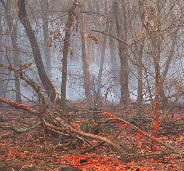
As the aliens spread over the surface of the earth, so does this insidious vegetation, hinting of the Martian desire to remove all traces of previous life from the planet's surface. While Speilberg's film characters may not say so in so many works, the gradual advance of the plants, their appearance in scenes symbolizes the touch of an alien presence. The slithering plants in fact strongly resemble the description Wells gave of the aliens themselves as well as the film's logo that depicts an alien's tentacle-like fingers gripping the planet earth. The blood-red vegetation may also be intended to strike at the subconscious of the film-goer, adding to film's impact - a constant alien fingerprint designed to tell everyone that the aliens had been to this place or that.
Spielberg, who seems to deal with strong symbolic imagery in his story-telling, reached back into the roots of his story in depicting scenes of red week's spread. In fact, during the shoot in Howell Township, New Jersey, Spielberg's crews not only created the red weed, but also the swamp out of which it emerged.
Wells, however, fully described red weed for Spielberg during a section of the novel in which the hero of the book is trapped in a house right along side one of the alien landing pits, from which many of the descriptions of the aliens and their way of life are depicted - and in the case of the red weed as well as other symbolic representations may well offer clues as to what we can expect to see when the film is released in June 2005.

"Apparently, the vegetable kingdom on Mars instead of having green for a dominant color is of a vivid blood red tint," Wells wrote. "At any rate, the seeds which Martians (intentionally or accidentally [sic]) brought with them gave rise in all cases to red colored growths. Only that - known popularly-as red weed, however, gained any footing in the competition with terrestrial forms."
Wells, who emerged at a time when Darwin's theories of evolution were emerging into the public scene - continued to hammer at the concept of "survival of the fittest" yet manages at the same time to give clues as to how humanity will overcome the invasion, that the Martian "will to survive" cannot overcome - despite its technological superiority - what ions of evolution had endowed humanity with and the best fitted to survive on the earth are those beings whose psychical forms have adapted to the conditions of the planet.
The red weed like the aliens, however, seems determined to put roots down on earth in the effort to transform the conditions here to suit the aliens.
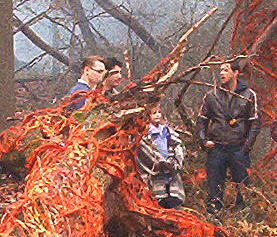
"The red creeper," Wells goes on, "was a quite transitory growth, and few people have seen it growing. For a time, however, the red weed grew with astonishing vigor."
It spread everywhere, giving the landscape a red tint.
"I found it broadcast throughout the country and especially wherever there was a stream of water," Wells wrote.
Spielberg's loyalty to the original book sent him and his crew to Howell Township where they created their own swamp and installed it with red weed. While security guards later told me that Spielberg had filled these woods with smoke, they neglected to point out, Spielberg had also filled the swamps with red weed for some of the more dramatic scenes of the movie.